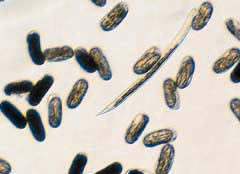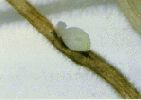Heterodera glycines
The Soybean cyst nematode
 |
 |
|
Eggs and juvenile
|
female on root
|
-
Damage to Soybean. Soybean cyst nematode is one of
the most important diseases of soybeans. Yield losses can be severe, approaching
100 percent in localized areas of infested fields. Even small populations
can cause serious damage.
-
Biology. In its juvenile form, Heterodera
glycines penetrates soybean roots. Those that become females
lose the ability to move, enlarge into a lemon-shaped "white female," which
breaks through the root surface, dies, and turns into a brown cyst or egg
case.
-
Ecology. SCN is relatively new to the midwest.
It was first found in the U.S. in 1954, probably inadvertantly introduced
in soil imported from the Orient.
-
Symptoms. Field symptoms of soybean cyst nematode
include yield loss,stunting and chlorosis. The only unique symptom of SCN
infection is the presence of white (or yellow) females on roots.
-
Damage to other crops. Heterodera glycines
is a pest on beans and other legumes, as well as numerous other plant species.
-
Control. Crop rotation and nematicides have limited
success, but once present in the soil, SCN can never be eliminated.
-
Links and References. Soybean
Cyst Nematode
|

